Understanding Automatic Watering Systems for Houseplants
What is an Automatic Watering System?
Automatic watering systems for houseplants are technological solutions designed to water plants with minimal human intervention. These systems can range from simple drip irrigation setups to sophisticated smart devices that control watering schedules based on soil moisture sensors.
Why Use an Automatic Watering System?
-
Convenience: Reduces the need for daily or weekly watering, allowing plant owners more time and flexibility.
-
Consistency: Delivers a consistent amount of water, preventing both overwatering and underwatering, which can be challenging for many plant enthusiasts.
-
Customization: Many systems offer customizable schedules, allowing users to tailor watering frequency and duration based on the specific needs of different plants.
-
Time-Saving: For busy professionals or those frequently traveling, these systems can manage watering effortlessly.
Types of Automatic Watering Systems
-
Drip Irrigation: Perfect for pots and containers, drip irrigation systems deliver water directly to the plant roots through a network of tubing and emitters.
-
Advantages: Efficient use of water, minimizes evaporation, and reduces weed growth.
-
Components: Includes drip tubes, emitters, connectors, and a water source.
-
-
Soaker Hoses: These porous hoses allow water to seep out slowly, providing moisture to the plants along their length.
- Advantages: Great for garden beds or multiple pots, easy to set up, and can be integrated with a timer.
-
Self-Watering Pots: These pots feature a reservoir at the bottom that allows plants to absorb water as needed through capillary action.
- Advantages: Ideal for busy individuals, minimizes maintenance, and helps to prevent root rot due to overwatering.
-
Smart Watering Systems: These are advanced systems that often connect to apps and provide insights into plant health, moisture levels, and weather forecasts.
- Advantages: Highly customizable, analytic features, and compatibility with home automation systems.
Key Features to Consider
-
Moisture Sensors: These sensors detect soil moisture levels and adjust watering accordingly. The more accurate the sensors, the better the plant health.
-
Timer and Scheduling Options: Having a timer allows you to set precise watering times. Some systems can adjust based on real-time weather conditions.
-
Capacity and Size: Depending on the number of plants, choose a system with an adequate water reservoir size to prevent frequent refills.
-
Adjustability: The ability to change watering amounts and schedules for different plants can be vital for a mixed plant environment.
-
Ease of Installation: Look for systems that are easy to set up without needing extensive plumbing experience.
Installation Tips
-
Planning: Identify all your houseplant locations and determine the best water source. This may be a faucet, rainwater collection, or a reservoir.
-
Layout: Sketch the layout of your system, indicating where hoses will run and where drip emitters should be placed.
-
Testing: After installation, run the system to check for leaks and ensure all plants receive adequate water.
-
Maintenance: Regularly check and clean the system components, such as filters and emitters, to prevent clogs.
Benefits of Automatic Watering Systems
-
Improved Plant Health: With consistent moisture levels, plants are less stressed, leading to healthier growth.
-
Water Conservation: Unlike traditional watering methods, these systems can significantly reduce water wastage.
-
Less Plant Loss: Automatic systems minimize the chances of accidental overwatering or drying out, which is particularly beneficial for novice plant owners.
-
Flexibility: Ideal for varied climates and individual plant needs; users can adapt to seasonal changes without hassle.
Potential Challenges
-
Initial Cost: Setting up an automatic watering system can have a higher upfront cost compared to manual watering.
-
Technological Issues: Smart systems may face connectivity or software issues which can lead to plants not being watered appropriately.
-
Dependency: Over-reliance on automatic systems can lead to neglecting the understanding of plant care basics.
Popular Brands and Products
-
Gardena: They offer a range of drip irrigation kits and hoses suitable for various houseplants.
-
Horizon Fertilizers: Known for practical self-watering pots integrating moisture control technology.
-
Blumat: Provides clay spikes that act as a reservoir, gradually releasing water into the soil.
-
Moisture Meters: While not a system, these devices can complement automated systems to monitor soil health.
Integrating Automatic Watering with Smart Home Technology
Many modern systems now integrate with smart home technologies. Users can connect their watering system to Wi-Fi, allowing them to control and monitor it in real-time through an app on their smartphones, often enabling more complex scheduling and notifications on plant status.
Conclusion: Automatic watering systems for houseplants provide a multitude of benefits, particularly in terms of consistency and convenience. From drip irrigation to smart watering systems, these technological advancements help ensure your plants receive the care they need without the constant need for attention. Whether you are a busy professional, a frequent traveler, or simply looking to simplify your plant care routine, investing in an automatic watering system can transform your indoor gardening experience. With the right setup, you can achieve healthy, thriving houseplants with minimal effort.
